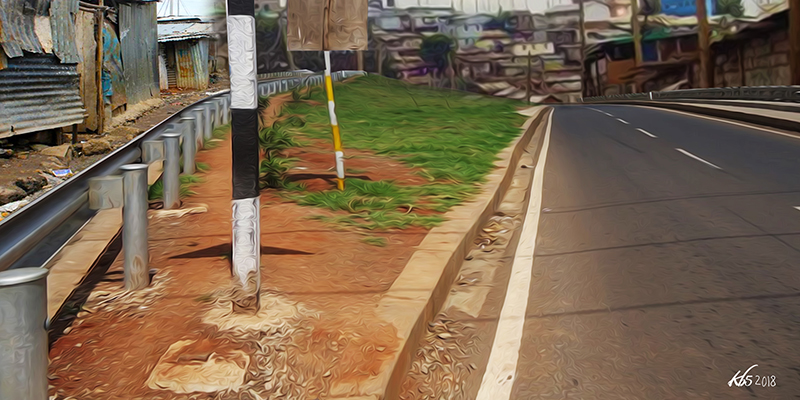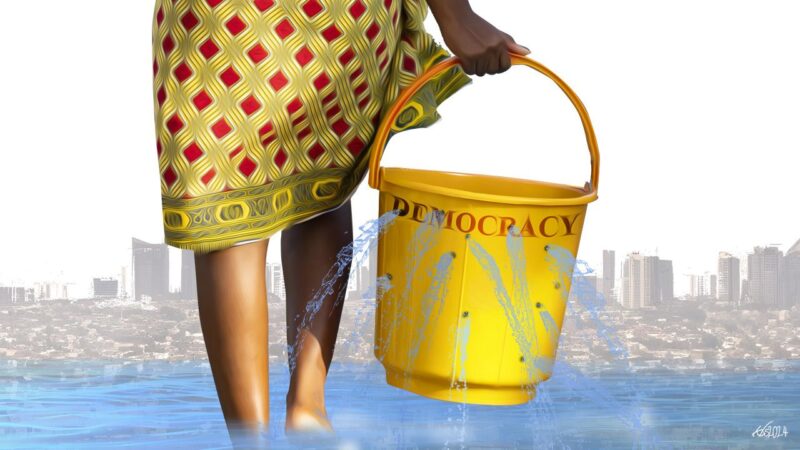It has been a long time since waist-high concrete beacons dropped down along the middle of the Kibera slum in Nairobi, marking the corridor of a future road and serving as an omen of change. But for almost two years, they stood rather impotently, largely ignored and even vandalised a few times, as no road came. Legal battles had frozen the encroaching highway in its tracks.
The road that was yet to come was Missing Link 12, a Sh2 billion four-lane highway partially funded by the Japanese government, one of many other “missing links” that would connect major highways in Nairobi. In the meantime, life in Kibera carried on for years between the beacons in that 600-metre-long corridor.
This changed on Friday, 20 July, 2018, when Maxwell (who requested that his surname not be used), who lived in Mashimoni, squarely within the road corridor, heard an announcement on the radio: “There will be a demolition on Monday morning.”
Word was starting to get around, but many were still making light of the news. After all, the road had been in the works for years and the Kenya Urban Roads Authority (KURA), the government body responsible for construction of this road, had just completed the first stage towards developing a Resettlement Action Plan (RAP) only days before. Maxwell recalls the radio ads sounding more like warnings for motorists to avoid the area because of possible demonstrations. He felt confident that the residents would be given a stronger warning the day before the actual demolition, but, just in case, he moved his belongings to his cousin’s home in Makina, a safe distance from the demolition zone.
Maxwell made the right call. At approximately 7am on Monday, 23 July, three bulldozers, accompanied by hundreds of heavily armed Administration Police officers, descended on houses, kiosks, churches, and schools from the Ngong Rd end to the Lang’ata Rd end of the corridor. The concrete beacons became marshals for a swift and total demolition.
KURA spokesperson, John Cheboi, told The Elephant that 2,182 structures within the corridor were targeted. According to Amnesty International Kenya, over 10,000 residents were displaced. It was the largest eviction to occur in Kibera since the 2009 relocation of 5,000 people from Soweto East under the Kenya Slum Upgrading Project, for which decanting sites were built in Lang’ata.
Several other Missing Links throughout the city will also require evictions, including at the Deep Sea slum in Parklands, which is scheduled to be cleared to complete Missing Link 15, a mass eviction which may affect another 3,000 people. On 19 July, the Multi-Sectoral Committee on Unsafe Structures released a public notice requesting that residents of Kaloleni, Makongeni, Mbotela, Mutindwa, Dandora, and Kenyatta University (Kamae) move voluntarily in advance of “the removal of all structures”.
KURA spokesperson, John Cheboi, told The Elephant that 2,182 structures within the corridor were targeted. According to Amnesty International Kenya, over 10,000 residents were displaced.
Legal framework on evictions
For a problem that is set to continue, Kenya has a comparatively imprecise legal framework on evictions. “There are enough constitutional provisions that would forbid the government from doing what it did that morning, but there is no eviction law,” says Irũngũ Houghton, the Executive Director of Amnesty International Kenya. Article 43(1b) of Kenya’s Constitution guarantees the right of every person to “accessible and adequate housing” and Article 40(4) affirms that, in the case that the state deprives any person of property, “provision may be made for compensation to be paid to occupants in good faith of land acquired under clause (3) who may not hold title to the land.” The Internally Displaced Persons Act of 2012 also holds that people displaced by “large-scale development projects” are entitled to a human rights-based process of eviction.
In addition, Kenya is party to the International Covenant on Economic, Social and Cultural Rights (ICESCR), the International Covenant on Civil and Political Rights (ICCPR), and the African Charter on Human and Peoples’ Rights. All of these uphold the right to adequate housing and, to varying degrees of specificity, provide guidelines for humane evictions within a human rights framework. Article 2(6) of the Constitution makes any treaty or convention ratified by Kenya part of Kenyan law.
There are also eviction guidelines from the Ministry of Housing that give, for example, conditions under which evictions should not occur, several of which were flagrantly violated in the Kibera demolition: no evictions in inclement weather, while students are in school, or without completion of a Resettlement Action Plan (RAP).
There have also been several major judicial precedents set in the last few years that interpret the Constitution to prioritise human rights, regardless of land ownership or tenancy status. In 2011, police and unidentified youth evicted more than 1,100 residents and destroyed 149 homes on public land near Garissa that was to be used for a road. The High Court, however, ordered the government to restore the evictees to their land, rebuild their homes, and pay Sh220 million in compensation, citing that evictees’ “rights to housing and to be treated with dignity and respect had been violated.”
There have also been several major judicial precedents set in the last few years that interpret the Constitution to prioritise human rights, regardless of land ownership or tenancy status.
Then in 2013, after the railway pension board gave residents of Muthurwa Estate in Nairobi 90 days to vacate before demolition, the High Court ruled that the board had violated evictees’ “rights to adequate housing and sanitation, and human dignity, and violated children’s rights to protection after it sent bulldozers to demolish hundreds of homes at dawn.” Judge Isaac Lenaola, in this ruling, added, “I must lament the widespread forced evictions that are occurring in the county coupled with a lack of adequate warning and compensation which are justified mainly by public demands for infrastructural developments.”
In the case of Missing Link 12, the High Court issued a similar order for Petition 974 (2016) requiring that a full RAP be completed before demolition. Shafi Ali Hussein, the director of the Nubian Rights Forum and one of the petitioners in that case, was present when KURA met with the Kenya National Human Rights Commission, the National Land Commission and Kibera community leaders. KURA agreed to roll out the RAP “with immediate effect”, according to Hussein. In the next few days, KURA staff began enumeration, the first step of a RAP where the number of structures is counted and basic information on affected residents collected.
However, according to Hussein, KURA seemed ill-prepared to carry out the exercise, and the forms that staff members used for the questionnaires did not have serial numbers. Enumeration finished on Friday, 20 July, the same day Maxwell heard the radio announcement warning of evictions. The following Monday, it was to continue by verifying the data that had been collected, the next step necessary for setting up a compensation scheme. “But on Monday, unfortunately, we saw bulldozers,” said Hussein.
According to KURA spokesperson, John Cheboi, residents and owners of structures within the corridor had been notified to vacate by 16 July. When The Elephant asked Cheboi why they began the enumeration exercise days after residents were allegedly told to vacate, he responded that they were called back for the exercise.
Anti-poor urban design
Nairobi has remained true to its origins as a city designed for its elite, leaving for its working class what were literally and now figuratively remain “labour reserves” – unserviced, unrecognised crevices between its formal parts. Though the colonial urban management philosophy that Africans were unfit for city life was in effect a ploy to keep cheap African labour available for European commercial farms in Rift Valley’s “White Highlands”, the result was chronic underinvestment in urban spaces for indigenous Kenyans.
Kefa Otiso, professor of geography at Bowling Green State University, explains that, in addition to other race-based policies that prioritised European and Asian access to land and other economic resources within Nairobi, this “return to the land” policy resulted in many indigenous Kenyans settling in unsafe urban and peri-urban areas; they became, in his words, “the precursor of many modern slum and squatter settlements that are vulnerable to forced evictions.”
Nairobi’s population is set to hit 6 million by 2030, according to the World Bank, and currently 60 percent of its residents live in informal settlements. Much of this growth is propelled by rural-to-urban migration. At the current rate of urbanisation, this means almost half a million new slum dwellers every year. At the same time, land prices in and around Nairobi are skyrocketing due to a growing influx of illicit money laundered primarily through real estate and property markets. For the growing number of low-income, working-class households looking for affordable housing in Nairobi, this leaves few options outside of informal settlements.
In many ways, Nairobi’s anti-poor urban design today is a facsimile of colonial plans. Many low-income households are forced into the city’s “low-quality, high-cost trap”, where landlords are free to pursue economic incentives without administrative oversight or protection for tenants. Lucrative and efficient, slum real estate allows landlords to quickly buy “rights” to build on the land and see a return on investment without truly being held accountable for structural integrity or, in the case of the Kibera demolition, secure location. Landlords actively continued to build within the Missing Link 12 corridor even though there was impending construction, and, with the shortage of cheap urban housing in Nairobi, one could always find tenants.
In many ways, Nairobi’s anti-poor urban design today is a facsimile of colonial plans. Many low-income households are forced into the city’s “low-quality, high-cost trap”, where landlords are free to pursue economic incentives without administrative oversight or protection for tenants.
In the ruling of the 2013 Muthurwa case, Judge Lenaola gave the Attorney General 90 days not only to outline the government’s policies on evictions and explain whether they meet international standards, but also to explain what positive steps they would take to realise the right to accessible and adequate housing as guaranteed in the Constitution. “The right to adequate housing cannot be aspirational and merely speculative,” Lenaola said. “It is a right which has crystallised and which the State must endeavor to realise.”
The everyday, systemic violence that policy wreaks on the urban poor is often obscured by the obvious, photographable violence of events like the July 23 demolition. But even the sensational images – like the viral photograph that uncomfortably compressed into a single frame two Kibera evictees standing on rubble and golfers preparing to tee off just a couple of hundred metres away – sent a simple message worth emphasising: that alleviating the suffering of certain people, even when the opportunity cost is low, is not worth it. A little more humanity – a few more hours’ notice, perhaps – still could not justify delay in progress.
“That breeds a sense of historical injustice, this sense that we’re tenants of the city, we don’t really own it,” says Houghton of conversations he has had with affected residents of Kibera, one of whom said, “The city belongs to others and we just move in and out of the pieces of land that they don’t want, until they want it.” That’s the cynicism that a lot of people in the community have now, according to Houghton.
The images from Monday were perhaps then a more honest reflection of how the city sees its poor, something usually otherwise masked by political mobilisation. The Kibera demolition would not have happened before the elections last year, says Maxwell from Mashimoni, and certainly not before “The Handshake.” Neutralised by bridges and alliances, the local and national leaders, who would have otherwise drawn energy from Kibera, an adversarial hotspot, and taken a staunchly antagonistic position at least in rhetoric, were too quiet.
Rights and laws aside, the Kibera demolition has already happened, and it cannot be disputed that in the moment it rendered, in Houghton’s words, “people indistinguishable from property”: simply a large, inconvenient unit of “unsafe structures” that must be removed to make space for development. It took two days to clear the entire corridor.








